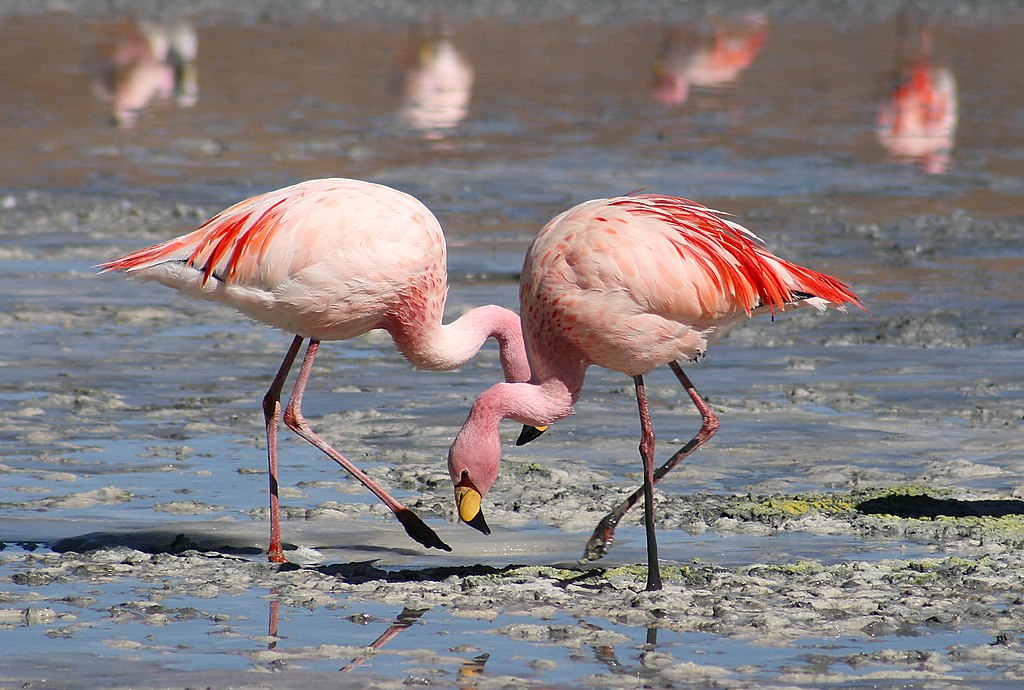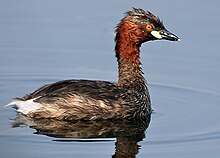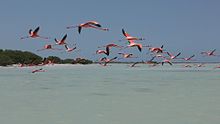Etymology
Captive greater flamingos feeding
Taxonomy and systematics
Traditionally, the long-legged Ciconiiformes, probably a paraphyletic assemblage, have been considered the flamingos' closest relatives and the family was included in the order. Usually, the ibises and spoonbills of the Threskiornithidae were considered their closest relatives within this order. Earlier genetic studies, such as those of Charles Sibley and colleagues, also supported this relationship.[3] Relationships to the waterfowl were considered as well,[4] especially as flamingos are parasitized by feather lice of the genus Anaticola, which are otherwise exclusively found on ducks and geese.[5] The peculiar presbyornithids were used to argue for a close relationship between flamingos, waterfowl, and waders.[6] A 2002 paper concluded they are waterfowl,[7] but a 2014 comprehensive study of bird orders found that flamingos and grebes are not waterfowl, but rather are part of Columbea along with doves, sandgrouse, and mesites.[8]Phylogeny
Living flamingoes.[9]
|
|||||||||||||||||||||||||||||||
Species
Six extant flamingo species are recognized by most sources, and were formerly placed in one genus – Phoenicopterus. As a result of a 2014 publication,[10] the family was reclassified into three genera.[11]| Species | Geographic location | |
|---|---|---|
| Greater flamingo (Phoenicopterus roseus) |
Old World | Parts of Africa, S. Europe and S. and SW Asia (most widespread flamingo). |
| Lesser flamingo (Phoeniconaias minor) |
Africa (e.g. Great Rift Valley) to NW India (most numerous flamingo). | |
| Chilean flamingo (Phoenicopterus chilensis) |
New World | Temperate S. South America. |
| James's flamingo (Phoenicoparrus jamesi) |
High Andes in Peru, Chile, Bolivia and Argentina. | |
| Andean flamingo (Phoenicoparrus andinus) |
High Andes in Peru, Chile, Bolivia and Argentina. | |
| American flamingo (Phoenicopterus ruber) |
Caribbean islands, Caribbean Mexico, Belize, Venezuela, and Galápagos Islands. | |
P. croizeti fossil
- Prehistoric species of flamingo:[citation needed]
- Phoenicopterus floridanus Brodkorb 1953 (Early Pliocene of Florida)
- Phoenicopterus stocki (Miller 1944) (Middle Pliocene of Rincón, Mexico)
- Phoenicopterus siamensis Cheneval et al. 1991
- Phoenicopterus gracilis Miller 1963 (Early Pleistocene of Lake Kanunka, Australia)
- Phoenicopterus copei (Late Pleistocene of W North America and C Mexico)
- Phoenicopterus minutus (Late Pleistocene of California, USA)
- Phoenicopterus croizeti (Middle Oligocene – Middle Miocene of C Europe)
- Phoenicopterus aethiopicus
- Phoenicopterus eyrensis (Late Oligocene of South Australia)
- Phoenicopterus novaehollandiae (Late Oligocene of South Australia)
Relationship with grebes
Many molecular and morphological studies support a relationship between grebes and flamingos.
For the grebe-flamingo clade, the taxon Mirandornithes ("miraculous birds" due to their extreme divergence and apomorphies) has been proposed. Alternatively, they could be placed in one order, with Phoenocopteriformes taking priority.[16]
Description
Flamingos usually stand on one leg while the other is tucked beneath their bodies. The reason for this behaviour is not fully understood. One theory is that standing on one leg allows the birds to conserve more body heat, given that they spend a significant amount of time wading in cold water.[17] However, the behaviour also takes place in warm water and is also observed in birds that do not typically stand in water. An alternative theory is that standing on one leg reduces the energy expenditure for producing muscular effort to stand and balance on one leg. A study on cadavers showed that the one-legged pose could be held without any muscle activity, while living flamingos demonstrate substantially less body sway in a one-legged posture.[18] As well as standing in the water, flamingos may stamp their webbed feet in the mud to stir up food from the bottom.[19]Flamingos are capable flyers, and flamingos in captivity often require wing clipping to prevent escape.
Flamingos in flight at Rio Lagartos, Yucatán, Mexico
The greater flamingo is the tallest of the 6 different species of flamingos, standing at 3.9 to 4.7 feet with a weight up to 7.7 pounds, and the shortest flamingo species (the lesser) has a height of 2.6 feet and weighs 5.5 pounds. Flamingos can have a wingspan as small as 37 inches to as big as 59 inches.[21]
Behaviour and ecology
Feeding
American flamingo and offspring: The arcuate (curved) bill is well adapted to bottom scooping.
Lifecycle
Chilean flamingo feeding its young
Colony of flamingos at Lake Nakuru
Flamingos form strong pair bonds, although in larger colonies, flamingos sometimes change mates, presumably because more mates are available to choose.[27] Flamingo pairs establish and defend nesting territories. They locate a suitable spot on the mudflat to build a nest (the spot is usually chosen by the female).[26] Copulation usually occurs during nest building, which is sometimes interrupted by another flamingo pair trying to commandeer the nesting site for their own use. Flamingos aggressively defend their nesting sites. Both the male and the female contribute to building the nest, and to defending the nest and egg.[28] Occasional same-sex pairs have been reported.[29]
After the chicks hatch, the only parental expense is feeding.[30] Both the male and the female feed their chicks with a kind of crop milk, produced in glands lining the whole of the upper digestive tract (not just the crop). Production is stimulated by the hormone prolactin. The milk contains fat, protein, and red and white blood cells. (Pigeons and doves—Columbidae—also produce a crop milk (just in the glands lining the crop), which contains less fat and more protein than flamingo crop milk.)[31]
For the first six days after the chicks hatch, the adults and chicks stay in the nesting sites. At around 7–12 days old, the chicks begin to move out of their nests and explore their surroundings. When they are two weeks old, the chicks congregate in groups, called "microcrèches", and their parents leave them alone. After a while, the microcrèches merge into "crèches" containing thousands of chicks. Chicks that do not stay in their crèches are vulnerable to predators.[32]
Status and conservation
In captivity
The first flamingo hatched in a European zoo was a Chilean flamingo at Zoo Basel in Switzerland in 1958. Since then, over 389 flamingos have grown up in Basel and been distributed to other zoos around the globe.[33]Greater, an at least 83-year-old greater flamingo, believed to be the oldest in the world, died at the Adelaide Zoo in Australia in January, 2014.[34]
Relationship with humans
Moche ceramic depicting flamingo (200 AD) Larco Museum Collection, Lima, Peru
- In Ancient Rome, their tongues were considered a delicacy.[35]
- In the Americas, the Moche people of ancient Peru worshipped nature.[36] They placed emphasis on animals and often depicted flamingos in their art.[37]
- In the Bahamas, they are the national bird.
- Andean miners have killed flamingos for their fat, believed to be a cure for tuberculosis.[38










No comments:
Post a Comment
Note: Only a member of this blog may post a comment.